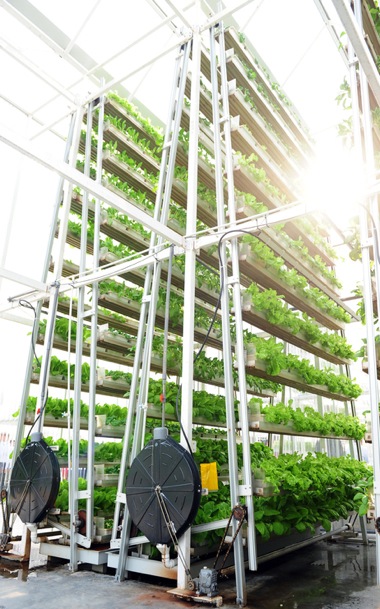Vertical Farming Is Key to the Smart Cities of the Future

Credit: MNDSingapore
Indoor crops flourish in a vertical farm in Singapore.
Smart cities could look very different from today’s urban centers. Streetlights could be communicating with bus stops, and subway trains could be solar powered. Population growth will force local government leaders to rethink more than just transportation and housing. As the population increases, the real estate needed to grow the food we eat will become increasingly scarce. Some experts have suggested that a new agricultural approach called vertical farming, also known as urban farming, could solve this problem. In a model that is already being tested in Singapore, crops are grown indoors in tall buildings. The benefits are extensive, the technology is powerful and the results are delicious.
What Is Vertical Farming?
Dickson Despommier is a professor of public health in environmental health sciences at Columbia University and has published a book on vertical farming. On his website, VerticalFarm.com, he puts into perspective the importance of innovation in agriculture:
By the year 2050, nearly 80% of the earth's population will reside in urban centers. Applying the most conservative estimates to current demographic trends, the human population will increase by about 3 billion people during the interim. An estimated 109 hectares of new land (about 20% more land than is represented by the country of Brazil) will be needed to grow enough food to feed them, if traditional farming practices continue as they are practiced today. At present, throughout the world, over 80% of the land that is suitable for raising crops is in use (sources: FAO and NASA). Historically, some 15% of that has been laid waste by poor management practices.
Read more on VerticalFarm.com.
What Are the Advantages of Vertical Farming?
The benefits of this new way of growing and harvesting food are numerous. Despommier provides a more complete list on his website, but here are a few key advantages to the vertical farming model:
- Year-round crop production; 1 indoor acre is equivalent to 4-6 outdoor acres or more, depending upon the crop (e.g., strawberries: 1 indoor acre = 30 outdoor acres)
- No weather-related crop failures due to droughts, floods, pests
- All VF food is grown organically: no herbicides, pesticides, or fertilizers
- VF dramatically reduces fossil fuel use (no tractors, plows, shipping.)
In addition to cutting down on fossil-fuel use during growth and harvesting, food can be grown very close to the cities where it will be sold and consumed. This cuts down on shipping and greatly reduces the health risks associated with transporting and protecting food in the farm-to-fork phase.
Vertical farming is more popular internationally, but it is taking hold in the United States as well:
In the U.S., vertical farms are sprouting in urban areas across the country, some in old buildings that have been repurposed for agriculture. One operation called the Plant is producing vegetables in a three-story former meatpacking facility on Chicago's South Side.
The farm grows vegetables on small rafts floating on water, which is filled with nutrients from waste produced by fish in a separate tank—a setup called aquaponics. Light comes from lamps designed to emit the proper wavelengths for plant growth. The Plant is also designing a growing system in which crops could grow sticking out at an upward angle from vertical boards, with nutrients provided to the plant roots by water dripping down a film from pipes near the ceiling.
The idea hasn’t been developed enough to feed large cities just yet, but it could be in the next 50 years. As technology progresses, the logistics of indoor farming become more feasible:
[Despommier] argues that the idea of vertical farming on a large scale will seem increasingly realistic as techniques evolve. He cites cellphones and plasma-screen televisions as examples of innovations that were unimaginable before their time.
"You have to start small and you have to start at the research level before you jump into the commercial aspect of this thing, but that's the way all these ideas start," Dr. Despommier says. "Everything we have in this world of ours started out crazy."
Read The Future of Agriculture May Be Up on The Wall Street Journal.
How could technology, and specifically big data, improve vertical farming? Let is know in the Comments section.








